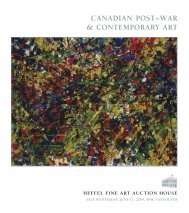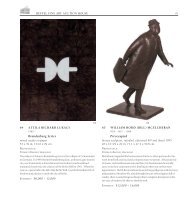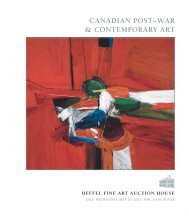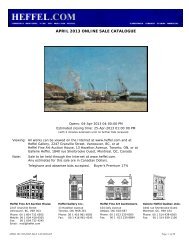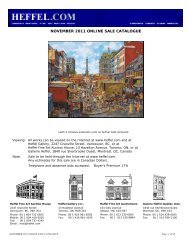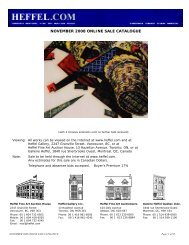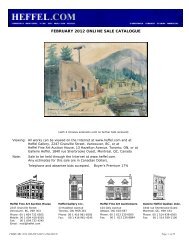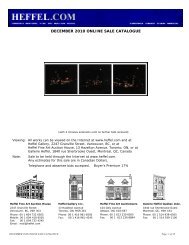Download Auction Catalogue in PDF Format - Heffel
Download Auction Catalogue in PDF Format - Heffel
Download Auction Catalogue in PDF Format - Heffel
Create successful ePaper yourself
Turn your PDF publications into a flip-book with our unique Google optimized e-Paper software.
HEFFEL FINE ART AUCTION HOUSE 35<br />
119 FRANK HANS (FRANZ) JOHNSTON<br />
ARCA CSPWC G7 OSA 1888 ~ 1949<br />
Algoma Tapestry<br />
oil on panel, signed Frank H. Johnston<br />
and on verso titled and dated 1918<br />
12 x 15 3/4 <strong>in</strong>, 30.5 x 40 cm<br />
PROVENANCE:<br />
Roberts Gallery, Toronto<br />
Family of Tom Thomson<br />
By descent to the present Private Collection, Calgary<br />
LITERATURE:<br />
Charles C. Hill, The Group of Seven, Art for A Nation,<br />
National Gallery of Canada, 1995, page 83<br />
Roger Burford Mason, A Grand Eye for Glory: A Life<br />
of Franz Johnston, 1998, page 36<br />
Algoma Tapestry is a rare early work that not only comes from the very<br />
first boxcar trip taken by Frank Johnston, Lawren Harris and J.E.H.<br />
MacDonald to Algoma, but also has a special provenance, hav<strong>in</strong>g passed<br />
by descent through the family of Tom Thomson to auction with <strong>Heffel</strong>.<br />
This f<strong>in</strong>e work, exemplary of Johnston’s decorative and panoramic style,<br />
was pa<strong>in</strong>ted <strong>in</strong> the fall of 1918 when the aforementioned artists, together<br />
with James MacCallum, went by tra<strong>in</strong> from Toronto to Sault Ste. Marie,<br />
and from there to Canyon, 113 miles north, where they spent a week<br />
pa<strong>in</strong>t<strong>in</strong>g the vivid and ever~chang<strong>in</strong>g autumn landscape. From Canyon<br />
they moved to Hubert on the Montreal River and then on to Batchawana,<br />
return<strong>in</strong>g to Toronto <strong>in</strong> early October. Despite the poor weather and<br />
constant grey skies, Johnston was prolific, produc<strong>in</strong>g 33 ple<strong>in</strong> air<br />
sketches. Upon his return to Toronto, he, Harris and MacDonald drew<br />
on this material to produce sufficient work to mount a show at The Art<br />
Gallery of Toronto (now the Art Gallery of Ontario) <strong>in</strong> April of 1919, a<br />
show that was considered a success. In their accompany<strong>in</strong>g text, the<br />
artists called upon their audience to accept the works as “evidence that<br />
Canadian artists were <strong>in</strong>terested <strong>in</strong> the discovery of their own country.”<br />
Brief statements, later termed “Algomaxims”, accompanied the works,<br />
such as “The great purpose of landscape art is to make us at home <strong>in</strong> our<br />
own country.” Another stated, “The old masters were young servants<br />
once,” and would have been directed at pa<strong>in</strong>ters far senior to the fledgl<strong>in</strong>g<br />
members of the Group, but holds a tell<strong>in</strong>g irony for us look<strong>in</strong>g back at<br />
their work now.<br />
The pictures were arranged chronologically, document<strong>in</strong>g the course of<br />
the journey as well as the chang<strong>in</strong>g colours of autumn. One can assume<br />
then ~ by comparison with other works from this trip ~ that Algoma<br />
Tapestry, due to the still~bright greens of the deciduous trees, is a very<br />
early first boxcar trip sketch. A second boxcar trip and another show<br />
followed <strong>in</strong> the fall of 1919, and it was on these two trips that Johnston<br />
sketched many of the scenes that would <strong>in</strong>spire his masterworks now<br />
resid<strong>in</strong>g <strong>in</strong> major public collections. The boxcar trips are an<br />
extraord<strong>in</strong>ary, almost mythic, chapter <strong>in</strong> Canadian art history, where<strong>in</strong><br />
likem<strong>in</strong>ded <strong>in</strong>dividuals experienced someth<strong>in</strong>g quite profound and<br />
produced work that has shaped the national identity of Canada’s visual<br />
arts. We tend to see the Group as a unit, and the danger of this lies <strong>in</strong><br />
forgett<strong>in</strong>g that each pa<strong>in</strong>ter was a very unique artist with his own<br />
<strong>in</strong>dividual aspirations. Johnston was a family man, an especially strong<br />
<strong>in</strong>dividualist, and felt that he could forge a path on his own, hav<strong>in</strong>g had<br />
better sales at his solo exhibitions than he did with the Group. The<br />
camaraderie and critical discourse of the artists who would become the<br />
Group of Seven was highly <strong>in</strong>fluential <strong>in</strong> Johnston’s work, but not so<br />
much as to <strong>in</strong>fluence his work to be similar to theirs; conversely, Johnston<br />
sought stylistic <strong>in</strong>dependence. He wanted his work to be discernable<br />
from that of the others, and would soon break from the Group, tak<strong>in</strong>g a<br />
job <strong>in</strong> W<strong>in</strong>nipeg shortly after the pa<strong>in</strong>ters formalized themselves as the<br />
Group of Seven.<br />
Johnston’s work is <strong>in</strong>deed different ~ he often selected a more panoramic<br />
view than his fellow pa<strong>in</strong>ters, a feel<strong>in</strong>g conveyed as much by the open<br />
treatment of the skies and forests <strong>in</strong> his works as by his ability to capture<br />
depth and pattern with clarity. His works are generally less tangled and<br />
wild, show<strong>in</strong>g us a more approachable sort of wilderness. Sadly, Johnston<br />
would destroy much of his early Group period work <strong>in</strong> the 1930s;<br />
Frankl<strong>in</strong> Arbuckle speaks of the artist “destroy<strong>in</strong>g about a hundred of his<br />
Group of Seven pa<strong>in</strong>t<strong>in</strong>gs” at that time. This lack of material has no doubt<br />
left gaps <strong>in</strong> our appreciation of Johnston’s work and further confirms the<br />
rarity of Algoma Tapestry.<br />
ESTIMATE: $40,000 ~ 50,000



